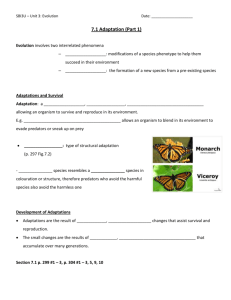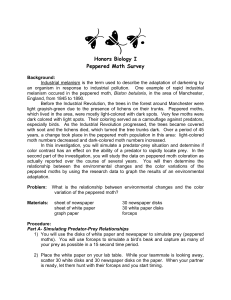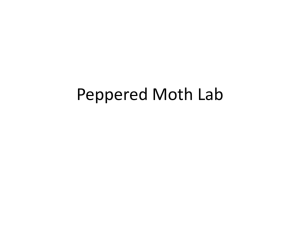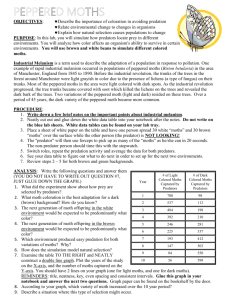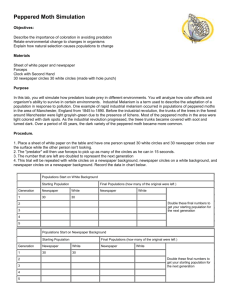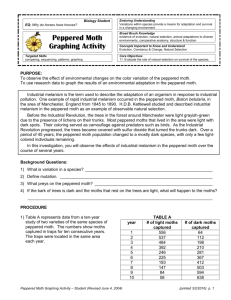Peppered Moth Simulation
advertisement
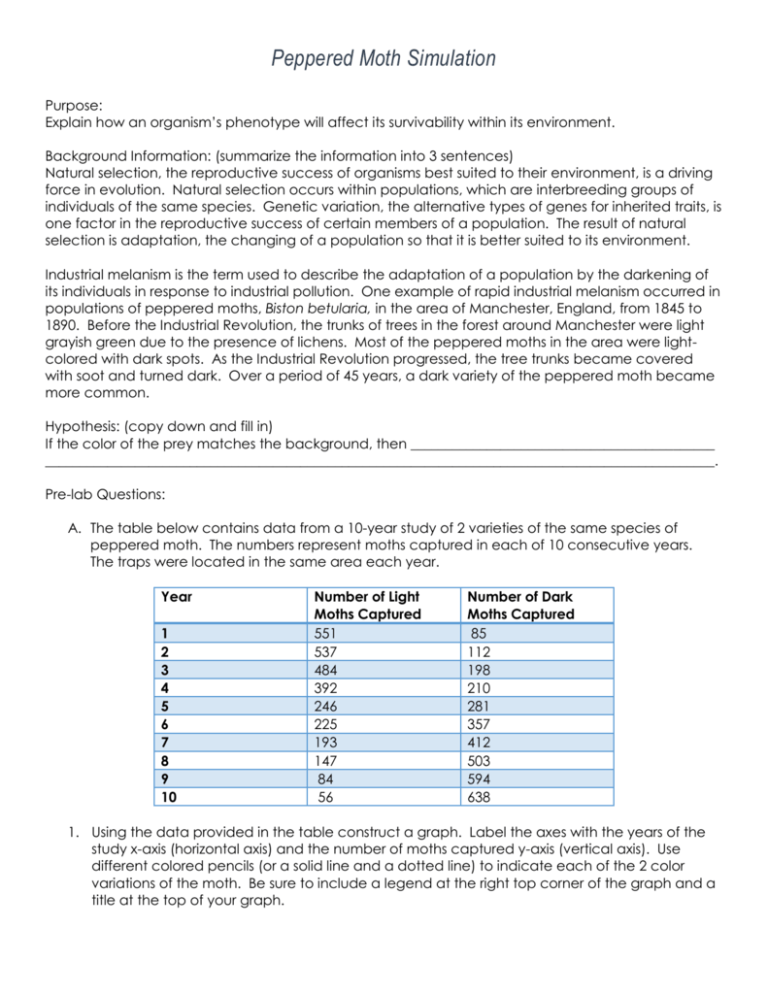
Peppered Moth Simulation Purpose: Explain how an organism’s phenotype will affect its survivability within its environment. Background Information: (summarize the information into 3 sentences) Natural selection, the reproductive success of organisms best suited to their environment, is a driving force in evolution. Natural selection occurs within populations, which are interbreeding groups of individuals of the same species. Genetic variation, the alternative types of genes for inherited traits, is one factor in the reproductive success of certain members of a population. The result of natural selection is adaptation, the changing of a population so that it is better suited to its environment. Industrial melanism is the term used to describe the adaptation of a population by the darkening of its individuals in response to industrial pollution. One example of rapid industrial melanism occurred in populations of peppered moths, Biston betularia, in the area of Manchester, England, from 1845 to 1890. Before the Industrial Revolution, the trunks of trees in the forest around Manchester were light grayish green due to the presence of lichens. Most of the peppered moths in the area were lightcolored with dark spots. As the Industrial Revolution progressed, the tree trunks became covered with soot and turned dark. Over a period of 45 years, a dark variety of the peppered moth became more common. Hypothesis: (copy down and fill in) If the color of the prey matches the background, then ____________________________________________ _________________________________________________________________________________________________. Pre-lab Questions: A. The table below contains data from a 10-year study of 2 varieties of the same species of peppered moth. The numbers represent moths captured in each of 10 consecutive years. The traps were located in the same area each year. Year 1 2 3 4 5 6 7 8 9 10 Number of Light Moths Captured 551 537 484 392 246 225 193 147 84 56 Number of Dark Moths Captured 85 112 198 210 281 357 412 503 594 638 1. Using the data provided in the table construct a graph. Label the axes with the years of the study x-axis (horizontal axis) and the number of moths captured y-axis (vertical axis). Use different colored pencils (or a solid line and a dotted line) to indicate each of the 2 color variations of the moth. Be sure to include a legend at the right top corner of the graph and a title at the top of your graph. Peppered Moth Simulation 2. Using the graph you made describe what happened in the population of peppered moths in the sample area. 3. What is the relationship between the environment and the color of the peppered moth? 4. Explain why an increase in the number of dark-colored peppered moths occurred during the Industrial Revolution. 5. What effect do you think the modern use of cleaner-burning fuels has on the environment and the peppered moths near Manchester, England today? Materials for lab activity: -Sheet of white paper -Sheet of newspaper -forceps -white paper disks (60) -newspaper disks (60) -timer Procedure: 1. Work with a partner, and decide which of you will be the “predator” and which will be the timekeeper. 2. Place a sheet of white paper on your lab table. If you are the timekeeper, scatter 30 whitepaper disks and 30 newspaper disks on the white paper while your partner looks away. The disks represent a bird’s prey. If you are the predator, use forceps to pick up as many disks as possible in 30 seconds while your lab partner watches the time. The forceps simulate a bird’s beak. 3. Count the number of each type of disk picked up in 30 seconds. Record these numbers in data table I below. 4. Replace the white paper with a sheet of newspaper. If you are the timekeeper, scatter 30 white paper disks and 30 newspaper disks on the newspaper. If you are the predator, repeat the hunting procedure while your partner watches the time. Again record the numbers in the data table. 5. Change roles, and repeat steps 2-4. 6. Use data table 2 to calculate the percent of available prey recovered for each trial. Data Table 1 Trial Back-ground 1 2 3 4 White paper Newspaper White paper Newspaper Newspaper disks scattered White disks scattered Disks picked up contrasting background Disks picked up matching background Data Table 2 Trial 1 2 3 4 % of available prey eaten contrasting % of available prey eaten matching Peppered Moth Simulation Analysis: 1. What do the two different backgrounds represent? 2. What did he experiment show about how prey are selected by predators? Did your experiment support your hypothesis? 3. If the cutouts represented moths, what moth coloration is best adapted for a dark (newspaper) background? How do you know? What data from your experiment can you use to support your answer? 4. Are the light and dark colored moths different species? How can you tell? (think about the definition of a species) 5. How might the gene for dark coloration in the peppered moth have originated? 6. How does the percent of prey-recovered compare between the two different backgrounds? 7. How does the data you collected in the experiment compare to the data from the 10-year study? Conclusion: Write a 5 sentence summary that includes the following items; a) what the experiment tested and showed, b) how the experiment relates to natural selection, and c) how the experiment is an example of evolution.



